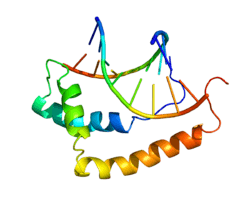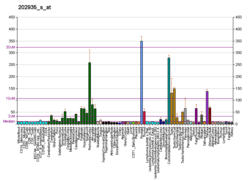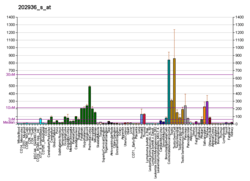SOX9
Transcription factor SOX-9 is a protein that in humans is encoded by the SOX9 gene.[5][6]
Function
SOX-9 recognizes the sequence CCTTGAG along with other members of the HMG-box class DNA-binding proteins. It is expressed by proliferating but not hypertrophic chondrocytes that is essential for differentiation of precursor cells into chondrocytes[7] and, with steroidogenic factor 1, regulates transcription of the anti-Müllerian hormone (AMH) gene.[6]
SOX-9 also plays a pivotal role in male sexual development; by working with Sf1, SOX-9 can produce AMH in Sertoli cells to inhibit the creation of a female reproductive system.[8] It also interacts with a few other genes to promote the development of male sexual organs. The process starts when the transcription factor Testis determining factor (encoded by the sex-determining region SRY of the Y chromosome) activates SOX-9 activity by binding to an enhancer sequence upstream of the gene.[9] Next, Sox9 activates FGF9 and forms feedforward loops with FGF9[10] and PGD2.[9] These loops are important for producing SOX-9; without these loops, SOX-9 would run out and the development of a female would almost certainly ensue. Activation of FGF9 by SOX-9 starts vital processes in male development, such as the creation of testis cords and the multiplication of Sertoli cells.[10] The association of SOX-9 and Dax1 actually creates Sertoli cells, another vital process in male development.[11] In the brain development, its murine ortholog Sox-9 induces the expression of Wwp1, Wwp2, and miR-140 to regulate cortical plate entry of newly born nerve cells, and regulate axon branching and axon formation in cortical neurons.[12]
Clinical significance
Mutations lead to the skeletal malformation syndrome campomelic dysplasia, frequently with autosomal sex-reversal[6] and cleft palate.[13]
SOX9 sits in a gene desert on 17q24 in humans. Deletions, disruptions by translocation breakpoints and a single point mutation of highly conserved non-coding elements located > 1 Mb from the transcription unit on either side of SOX9 have been associated with Pierre Robin Sequence, often with a cleft palate.[13][14]
The Sox9 protein has been implicated in both initiation and progression of multiple solid tumors.[15] Its role as a master regulator of morphogenesis during human development makes it an ideal candidate for perturbation in malignant tissues. Specifically, Sox9 appears to induce invasiveness and therapy-resistance in prostate,[16] colorectal,[17] breast[18] and other cancers, and therefore promotes lethal metastasis.[19] Many of these oncogenic effects of Sox9 appear dose dependent.[20][16][15]
SOX9 localisation and dynamics
SOX9 is mostly localised in the nucleus and it is highly mobile. Studies in chondrocyte cell line has revealed nearly 50% of SOX9 is bound to DNA and it is directly regulated by external factors. Its half-time of residence on DNA is ~14 seconds.[21]
Role in sex reversal
Mutations in Sox9 or any associated genes can cause reversal of sex and hermaphroditism (or intersexuality in humans). If Fgf9, which is activated by Sox9, is not present, a fetus with both X and Y chromosomes can develop female gonads;[9] the same is true if Dax1 is not present.[11] The related phenomena of hermaphroditism can be caused by unusual activity of the SRY, usually when it's translocated onto the X-chromosome and its activity is only activated in some cells.[22]
Interactions
SOX9 has been shown to interact with Steroidogenic factor 1,[8] MED12[23] and MAF.[24]
See also
- SOX genes
Further reading
- Ninomiya S, Narahara K, Tsuji K, Yokoyama Y, Ito S, Seino Y (March 1995). "Acampomelic campomelic syndrome and sex reversal associated with de novo t(12;17) translocation". American Journal of Medical Genetics. 56 (1): 31–4. doi:10.1002/ajmg.1320560109. PMID 7747782.
- Lefebvre V, de Crombrugghe B (March 1998). "Toward understanding SOX9 function in chondrocyte differentiation". Matrix Biology. 16 (9): 529–40. doi:10.1016/S0945-053X(98)90065-8. PMID 9569122.
- Harley VR (2002). The molecular action of testis-determining factors SRY and SOX9. Novartis Found. Symp. Novartis Foundation Symposia. 244. pp. 57–66, discussion 66–7, 79–85, 253–7. doi:10.1002/0470868732.ch6. ISBN 9780470843468. PMID 11990798.
- Kwok C, Weller PA, Guioli S, Foster JW, Mansour S, Zuffardi O, et al. (November 1995). "Mutations in SOX9, the gene responsible for Campomelic dysplasia and autosomal sex reversal". American Journal of Human Genetics. 57 (5): 1028–36. PMC 1801368. PMID 7485151.
- Foster JW, Dominguez-Steglich MA, Guioli S, Kwok C, Weller PA, Stevanović M, et al. (December 1994). "Campomelic dysplasia and autosomal sex reversal caused by mutations in an SRY-related gene". Nature. 372 (6506): 525–30. Bibcode:1994Natur.372..525F. doi:10.1038/372525a0. PMID 7990924.
- Wagner T, Wirth J, Meyer J, Zabel B, Held M, Zimmer J, et al. (December 1994). "Autosomal sex reversal and campomelic dysplasia are caused by mutations in and around the SRY-related gene SOX9". Cell. 79 (6): 1111–20. doi:10.1016/0092-8674(94)90041-8. PMID 8001137.
- Südbeck P, Schmitz ML, Baeuerle PA, Scherer G (June 1996). "Sex reversal by loss of the C-terminal transactivation domain of human SOX9". Nature Genetics. 13 (2): 230–2. doi:10.1038/ng0696-230. PMID 8640233.
- Cameron FJ, Hageman RM, Cooke-Yarborough C, Kwok C, Goodwin LL, Sillence DO, Sinclair AH (October 1996). "A novel germ line mutation in SOX9 causes familial campomelic dysplasia and sex reversal". Human Molecular Genetics. 5 (10): 1625–30. doi:10.1093/hmg/5.10.1625. PMID 8894698.
- Meyer J, Südbeck P, Held M, Wagner T, Schmitz ML, Bricarelli FD, et al. (January 1997). "Mutational analysis of the SOX9 gene in campomelic dysplasia and autosomal sex reversal: lack of genotype/phenotype correlations". Human Molecular Genetics. 6 (1): 91–8. doi:10.1093/hmg/6.1.91. PMID 9002675.
- Cameron FJ, Sinclair AH (1997). "Mutations in SRY and SOX9: testis-determining genes". Human Mutation. 9 (5): 388–95. doi:10.1002/(SICI)1098-1004(1997)9:5<388::AID-HUMU2>3.0.CO;2-0. PMID 9143916.
- Wunderle VM, Critcher R, Hastie N, Goodfellow PN, Schedl A (September 1998). "Deletion of long-range regulatory elements upstream of SOX9 causes campomelic dysplasia". Proceedings of the National Academy of Sciences of the United States of America. 95 (18): 10649–54. Bibcode:1998PNAS...9510649W. doi:10.1073/pnas.95.18.10649. PMC 27949. PMID 9724758.
- De Santa Barbara P, Bonneaud N, Boizet B, Desclozeaux M, Moniot B, Sudbeck P, et al. (November 1998). "Direct interaction of SRY-related protein SOX9 and steroidogenic factor 1 regulates transcription of the human anti-Müllerian hormone gene". Molecular and Cellular Biology. 18 (11): 6653–65. doi:10.1128/mcb.18.11.6653. PMC 109250. PMID 9774680.
- McDowall S, Argentaro A, Ranganathan S, Weller P, Mertin S, Mansour S, et al. (August 1999). "Functional and structural studies of wild type SOX9 and mutations causing campomelic dysplasia". The Journal of Biological Chemistry. 274 (34): 24023–30. doi:10.1074/jbc.274.34.24023. PMID 10446171.
- Huang W, Zhou X, Lefebvre V, de Crombrugghe B (June 2000). "Phosphorylation of SOX9 by cyclic AMP-dependent protein kinase A enhances SOX9's ability to transactivate a Col2a1 chondrocyte-specific enhancer". Molecular and Cellular Biology. 20 (11): 4149–58. doi:10.1128/MCB.20.11.4149-4158.2000. PMC 85784. PMID 10805756.
- Thong MK, Scherer G, Kozlowski K, Haan E, Morris L (August 2000). "Acampomelic campomelic dysplasia with SOX9 mutation". American Journal of Medical Genetics. 93 (5): 421–5. doi:10.1002/1096-8628(20000828)93:5<421::AID-AJMG14>3.0.CO;2-5. PMID 10951468.
- Ninomiya S, Yokoyama Y, Teraoka M, Mori R, Inoue C, Yamashita S, et al. (September 2000). "A novel mutation (296 del G) of the SOX90 gene in a patient with campomelic syndrome and sex reversal". Clinical Genetics. 58 (3): 224–7. doi:10.1034/j.1399-0004.2000.580310.x. PMID 11076045.
- Preiss S, Argentaro A, Clayton A, John A, Jans DA, Ogata T, et al. (July 2001). "Compound effects of point mutations causing campomelic dysplasia/autosomal sex reversal upon SOX9 structure, nuclear transport, DNA binding, and transcriptional activation". The Journal of Biological Chemistry. 276 (30): 27864–72. doi:10.1074/jbc.M101278200. PMID 11323423.
References
- GRCh38: Ensembl release 89: ENSG00000125398 - Ensembl, May 2017
- GRCm38: Ensembl release 89: ENSMUSG00000000567 - Ensembl, May 2017
- "Human PubMed Reference:". National Center for Biotechnology Information, U.S. National Library of Medicine.
- "Mouse PubMed Reference:". National Center for Biotechnology Information, U.S. National Library of Medicine.
- Tommerup N, Schempp W, Meinecke P, Pedersen S, Bolund L, Brandt C, et al. (June 1993). "Assignment of an autosomal sex reversal locus (SRA1) and campomelic dysplasia (CMPD1) to 17q24.3-q25.1". Nature Genetics. 4 (2): 170–4. doi:10.1038/ng0693-170. PMID 8348155.
- "Entrez Gene: SOX9 SRY (sex determining region Y)-box 9 (campomelic dysplasia, autosomal sex-reversal)".
- Robbins and Cotran pathologic basis of disease (Ninth ed.). p. 1182. ISBN 9780808924500.
- De Santa Barbara P, Bonneaud N, Boizet B, Desclozeaux M, Moniot B, Sudbeck P, et al. (November 1998). "Direct interaction of SRY-related protein SOX9 and steroidogenic factor 1 regulates transcription of the human anti-Müllerian hormone gene". Molecular and Cellular Biology. 18 (11): 6653–65. doi:10.1128/mcb.18.11.6653. PMC 109250. PMID 9774680.
- Moniot B, Declosmenil F, Barrionuevo F, Scherer G, Aritake K, Malki S, et al. (June 2009). "The PGD2 pathway, independently of FGF9, amplifies SOX9 activity in Sertoli cells during male sexual differentiation". Development. 136 (11): 1813–21. doi:10.1242/dev.032631. PMC 4075598. PMID 19429785.
- Kim Y, Kobayashi A, Sekido R, DiNapoli L, Brennan J, Chaboissier MC, et al. (June 2006). "Fgf9 and Wnt4 act as antagonistic signals to regulate mammalian sex determination". PLOS Biology. 4 (6): e187. doi:10.1371/journal.pbio.0040187. PMC 1463023. PMID 16700629.
- Bouma GJ, Albrecht KH, Washburn LL, Recknagel AK, Churchill GA, Eicher EM (July 2005). "Gonadal sex reversal in mutant Dax1 XY mice: a failure to upregulate Sox9 in pre-Sertoli cells". Development. 132 (13): 3045–54. doi:10.1242/dev.01890. PMID 15944188.
- Ambrozkiewicz MC, Schwark M, Kishimoto-Suga M, Borisova E, Hori K, Salazar-Lázaro A, et al. (December 2018). "Polarity Acquisition in Cortical Neurons Is Driven by Synergistic Action of Sox9-Regulated Wwp1 and Wwp2 E3 Ubiquitin Ligases and Intronic miR-140". Neuron. 100 (5): 1097–1115.e15. doi:10.1016/j.neuron.2018.10.008. PMID 30392800.
- Dixon MJ, Marazita ML, Beaty TH, Murray JC (March 2011). "Cleft lip and palate: understanding genetic and environmental influences". Nature Reviews. Genetics. 12 (3): 167–78. doi:10.1038/nrg2933. PMC 3086810. PMID 21331089.
- Benko S, Fantes JA, Amiel J, Kleinjan DJ, Thomas S, Ramsay J, et al. (March 2009). "Highly conserved non-coding elements on either side of SOX9 associated with Pierre Robin sequence". Nature Genetics. 41 (3): 359–64. doi:10.1038/ng.329. PMID 19234473.
- Jo, A; Denduluri, S; Zhang, B; Wang, Z; Yin, L; Yan, Z; Kang, R; Shi, LL; Mok, J; Lee, MJ; Haydon, RC (December 2014). "The versatile functions of Sox9 in development, stem cells, and human diseases". Genes & Diseases. 1 (2): 149–161. doi:10.1016/j.gendis.2014.09.004. PMC 4326072. PMID 25685828.
- Nouri, M; Massah, S; Caradec, J; Lubik, AA; Li, N; Truong, S; Lee, AR; Fazli, L; Ramnarine, VR; Lovnicki, JM; Moore, J; Wang, M; Foo, J; Gleave, ME; Hollier, BG; Nelson, C; Collins, C; Dong, X; Buttyan, R (9 January 2020). "Transient Sox9 Expression Facilitates Resistance to Androgen-Targeted Therapy in Prostate Cancer". Clinical Cancer Research. 26 (7): 1678–1689. doi:10.1158/1078-0432.CCR-19-0098. PMID 31919137.
- Prévostel, C; Blache, P (November 2017). "The dose-dependent effect of SOX9 and its incidence in colorectal cancer". European Journal of Cancer. 86: 150–157. doi:10.1016/j.ejca.2017.08.037. PMID 28988015.
- Grimm, D; Bauer, J; Wise, P; Krüger, M; Simonsen, U; Wehland, M; Infanger, M; Corydon, TJ (23 March 2019). "The role of SOX family members in solid tumours and metastasis". Seminars in Cancer Biology. doi:10.1016/j.semcancer.2019.03.004. PMID 30914279.
- Aguilar-Medina, M; Avendaño-Félix, M; Lizárraga-Verdugo, E; Bermúdez, M; Romero-Quintana, JG; Ramos-Payan, R; Ruíz-García, E; López-Camarillo, C (2019). "SOX9 Stem-Cell Factor: Clinical and Functional Relevance in Cancer". Journal of Oncology. 2019: 6754040. doi:10.1155/2019/6754040. PMC 6463569. PMID 31057614.
- Yang, X; Liang, R; Liu, C; Liu, JA; Cheung, MPL; Liu, X; Man, OY; Guan, XY; Lung, HL; Cheung, M (14 January 2019). "SOX9 is a dose-dependent metastatic fate determinant in melanoma". Journal of Experimental & Clinical Cancer Research : CR. 38 (1): 17. doi:10.1186/s13046-018-0998-6. PMC 6330758. PMID 30642390.
- Govindaraj K, Hendriks J, Lidke DS, Karperien M, Post JN (January 2019). "Changes in Fluorescence Recovery After Photobleaching (FRAP) as an indicator of SOX9 transcription factor activity". Biochimica et Biophysica Acta (BBA) - Gene Regulatory Mechanisms. 1862 (1): 107–117. doi:10.1016/j.bbagrm.2018.11.001. PMID 30465885.
- Margarit E, Coll MD, Oliva R, Gómez D, Soler A, Ballesta F (January 2000). "SRY gene transferred to the long arm of the X chromosome in a Y-positive XX true hermaphrodite". American Journal of Medical Genetics. 90 (1): 25–8. doi:10.1002/(SICI)1096-8628(20000103)90:1<25::AID-AJMG5>3.0.CO;2-5. PMID 10602113.
- Zhou R, Bonneaud N, Yuan CX, de Santa Barbara P, Boizet B, Schomber T, et al. (July 2002). "SOX9 interacts with a component of the human thyroid hormone receptor-associated protein complex". Nucleic Acids Research. 30 (14): 3245–52. doi:10.1093/nar/gkf443. PMC 135763. PMID 12136106.
- Huang W, Lu N, Eberspaecher H, De Crombrugghe B (December 2002). "A new long form of c-Maf cooperates with Sox9 to activate the type II collagen gene". The Journal of Biological Chemistry. 277 (52): 50668–75. doi:10.1074/jbc.M206544200. PMID 12381733.
External links
- SOX9+protein,+human at the US National Library of Medicine Medical Subject Headings (MeSH)
- SOX9 human gene location in the UCSC Genome Browser.
- SOX9 human gene details in the UCSC Genome Browser.
- Overview of all the structural information available in the PDB for UniProt: P48436 (Human Transcription factor SOX-9) at the PDBe-KB.
- Overview of all the structural information available in the PDB for UniProt: Q04887 (Mouse Transcription factor SOX-9) at the PDBe-KB.
This article incorporates text from the United States National Library of Medicine, which is in the public domain.






